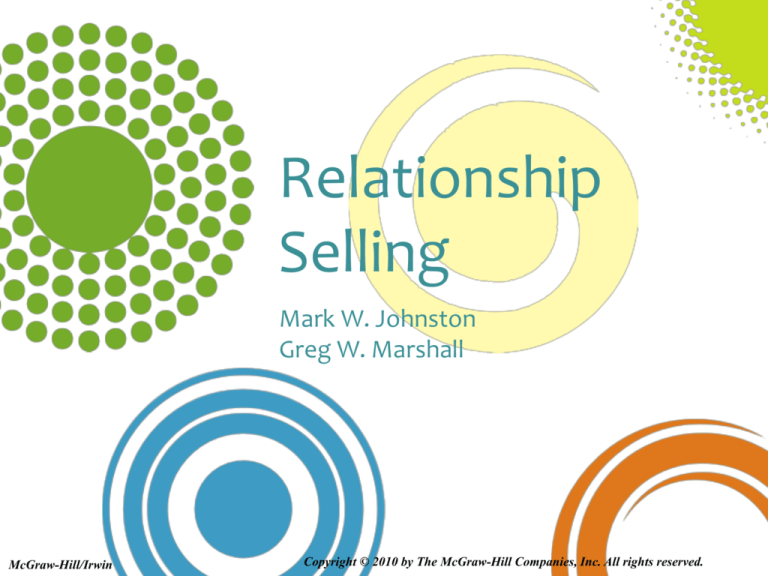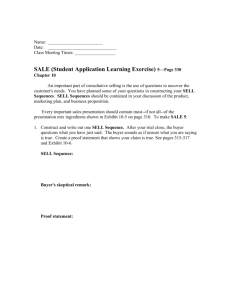
Relationship
Selling
Mark W. Johnston
Greg W. Marshall
McGraw-Hill/Irwin
Copyright © 2010 by The McGraw-Hill Companies, Inc. All rights reserved.
Communicating
the Sales
Message
Chapter 6
6-3
Learning Objectives
• Understand the characteristics of a sales
presentation
• Identify sales presentation strategies
• Discuss the steps in preparing for the
sales presentation
• Discuss the steps involved in approaching
the customer
6-4
Learning Objectives
• Understand how to apply your sales
knowledge to the customer’s needs
• Understand how important product
demonstrations are in the presentation
• Define the keys to a great sales
presentation
• Understand the role sales managers play
in sales presentations
6-5
Sales Presentation
• Delivery of information relevant to
solving the customer’s needs
• Often involves a product
demonstration
6-6
Exhibit 6.1
Characteristics of a Great Sales
Presentation
•
•
•
•
Explains the Value Proposition
Asserts the advantages and benefits of the
product
Enhances the customer’s knowledge of the
company, product, and services
Creates a memorable experience
6-7
Exhibit 6.2
Sales Presentation Strategies
Presentation
Strategy
Focal Point of
Presentation
Talk/Listen Ratio
Memorized
Product
90/10
Formula
Product
70/30
Need satisfaction
Customer
40/60
Problem solving
Customer
30/70
6-8
Memorized Presentations
• May discuss some areas not important to
the customer and leave out some that are
• Tend to seem high pressure
• Ensure consistent delivery
• Are able to deliver more information in
the same amount of time
6-9
Formula Presentations - AIDA
• Get the customer’s attention
• Create interest in the product
• Develop a strong desire for the
product
• Move the customer to action
6-10
Need Satisfaction
Presentations
•
•
•
Need identification stage – questioning the
customer to discover needs
Need analysis stage – by combining
knowledge of the company’s products and
services with the recognition of the
customer’s needs, determining how to best
meet those needs
Need satisfaction stage – presenting the
company’s solution to the customer’s needs
6-11
Problem-Solving
Presentations
• Focus on customer
• Considered the most complex and difficult
presentation strategy
• Preferred presentation strategy in
relationship selling
6-12
Presentation Goals and
Objectives
• Educate the customer
• Get the customer’s attention
• Build interest for the company’s products
and services
• Nurture the customer’s desire and
conviction
• Obtain a customer commitment to action
(purchase)
6-13
Approach the Customer
•
•
Before the meeting – never make the customer wait
Greeting the customer
•
•
•
•
Dress appropriately
Turn off or silence all wireless communication
devices
Be organized
The first three minutes
•
•
Build rapport
Non-controversial subjects
6-14
Objectives of the Customer
Approach
• Get the customer’s attention
• Create enough interest in you, your
company, and its products and services
that you can continue the presentation
6-15
Leadership 6.1
Never Underestimate the Power of Your
First Impression
• Portray a confident but not superior
manner
• A clean, neat appearance is essential to
making a positive first impression
• It’s important to smile
• Try to use your prospect’s name when
conversing
6-16
Leadership 6.1
Never Underestimate the Power of Your
First Impression
• Show that this meeting is important to
you
• Don’t apologize for taking your prospect’s
time
• Be comfortable and relaxed
• Position yourself through everything you
say and do
6-17
Exhibit 6.3
Approaches to the Sales Presentation
• Referral
• Customer Benefit
• Question
• Assessment
• Product demonstration
6-18
Exhibit 6.4
The Sales Presentation
6-19
Exhibit 6.5
Categories of Questions
Question Type
Advantage
Disadvantage
Unrestricted
Encourages customer to
speak
Time consuming
Restricted
Gets specific information
Discourages dialogue
Data Collection
Uncovers relevant data
Wastes customer time
Investigation
Helps uncover customer
needs
Difficult to manage
responses
Validation
Provides customer buy-in
Can derail presentation
6-20
Questioning Drives a Great
Presentation
•
Unrestricted/restricted questions – encourage
the customer to share information
•
•
Unrestricted – encourage the customer to
speak more freely and salesperson to develop
a richer understanding of the customer’s
needs
Restricted – provide specific information from
the customer that the salesperson can use to
shape the presentation
6-21
Questioning Drives a Great
Presentation
•
Data collection questions
•
•
Gather basic data about customer’s current
business or historical perspective
Limit use in presentations
•
•
•
May provide information that interferes with
elements of the presentation
Customer may perceive a lack of preparation
Investigation questions – assess the customer’s
current state of mind
6-22
Questioning Drives a Great
Presentation
• Validation questions – help get agreement
from the customer
• Situation questions – provide basic
information about the customer’s
situation
• Problem questions – get the customer
concentrating on particular issues
6-23
Questioning Drives a Great
Presentation
• Implication questions – help the customer
recognize a problem’s implications
• Need payoff questions – directly connect
the problem with the value proposition
6-24
Leadership 6.2
The SPIN Selling Approach
Situation Questions
Finding facts about the customer’s
existing situation
Problem Questions
Learning about the customer’s
problems
Implication Questions
Learning about the effects of the
customer’s problems
Need Payoff Questions
Learning about the value of a
proposed customer solution
6-25
Listening
•
•
•
•
In sales, listening is as, or more, important than
talking
Most people listen actively only 25% of the time
Most people can hear up to 800 words per
minute, but only speak around 140 words per
minute
Active listening - requires commitment to focus
on the speaker, concentrate on what is being
said, and take in nonverbal as well as verbal
messages
6-26
Exhibit 6.6
Guidelines for Active Listening
•
•
•
•
•
Listen patiently
Try to understand the feeling the other person is
expressing
Restate the person’s feeling
Allow time for discussion to continue without
interruption
Avoid direct questions and arguments about facts
6-27
Exhibit 6.6
Guidelines for Active Listening
• Repeat points you want to know more
about
• Listen for what is not said
• When solicited, be honest in your reply
• Do not get emotionally involved
• BE QUIET
6-28
Sell FAB
• Feature – any material characteristic or
specification of the company’s products
or services
• Advantage – a particular product/service
characteristic that helps meet the
customer’s needs
• Benefit – the beneficial outcome to the
buyer from the advantage found in the
product feature
6-29
Satisfy Customer Needs
• Get customer agreement
• Minimize change conflict
• Establish the relationship
6-30
Exhibit 6.7
Demonstration Checklist
• Justify the need for a product
demonstration
• State the objective of the demonstration
• Design the demonstration
• Rehearse the demonstration
• Plan for unforeseen circumstances
6-31
Demonstrations
•
Benefits
•
•
•
•
Can build credibility with customers
Create a greater connection between the customer and the
product
Enhance the effectiveness of your communication
Prepare
•
•
•
Develop objectives
Get customers involved
Practice, practice, practice
6-32
How to be a Better Communicator
• Focus on listening
• Ask for clarification
• Be brief
• Don’t repeat yourself
• Ask, “Am I making sense?”
• Have an open-door policy
• Use self-deprecating humor
McGraw-Hill/Irwin © 2009 The McGraw-Hill Companies, Inc. All rights reserved.
Innovation 6.3
6-33
Value Proposition
• Summary of value customer receives
based on expected benefits and costs
• Should be part of every presentation
• Build a financial business case
6-34
Nonverbal Communication
• Nonverbal communication is the most
important element in the communication
process
• Less than 10% of communication is based
on what we say
6-35
Customer Nonverbal
Communication
•
•
•
Face – single most important feature in
nonverbal communication
Arms and hands – open indicate person is open
to communication
Body language
•
•
•
Leaning forward = interest
Leaning backward = lack of concentration
Quick movements = change of mind
6-36
Territorial Space
6-37
When Things Go Wrong
• Interruptions during the Presentation
• Assess nature of interruption
• Consider as an opportunity to plan
where to take the presentation from
here
• Inappropriate Environment - be prepared
for less than ideal conditions
• Technology Failure – always have a
backup plan
6-38
Sales Manager’s Role
• Mentor – help salespeople improve their
presentation skills
• Salesperson – especially at presentations
to large customers
• Equip salespeople for success
• Training
• Equipment
• Motivation
6-39
Role Play
http://www.mhhe.com/business/marketing/videos/RS/06_RP_communicating_sales_message.mp4
6-40
6-41




